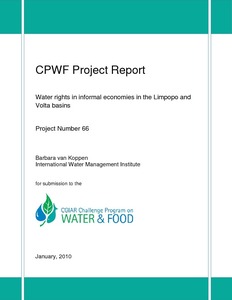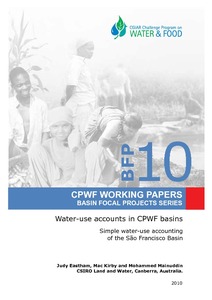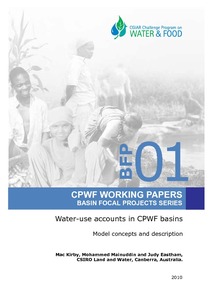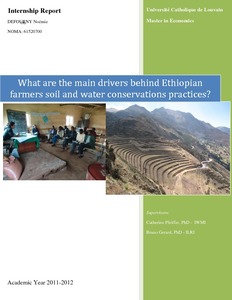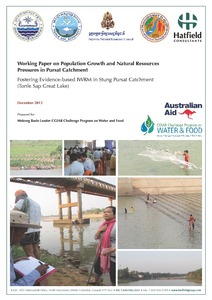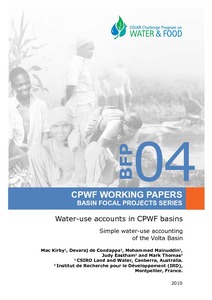gestão da água
AGROVOC URI:
Water rights in informal economies in the Limpopo and Volta basins
Most African countries underwent water legislation reform since the 1990s, through
which existing plural legal systems were changed into nation-wide permit systems, in
which the state acts as custodian of the nation’s water resources. Although globally
heralded as the best way to manage water resources within the broader context of
Integrated Water Resource Management, this project examines the problematic
implications of the new laws for the majority of the rural and peri-urban poor. Since time
Water productivity impacts in the Nile BDC projects
In early May 2011, people working on the Nile Basin Development Challenge (http://nilebdc.org) met in Addis Ababa in a 'science and reflection workshop'. In this session 4 of the workshop, participants discussed what-how-why of some of the different aspects of water and productivity across Nile projects. This video contains video reports from the group discussions
Water users associations in the NEN [Near East and North Africa] Region: IFAD interventions and overall dynamics. [Project report submitted to IFAD by IWMI]
Water resource research and education in mountain communities
High elevation páramo (wetland) ecosystems in the Andes are important water sources for local communities and downstream agricultural and urban users. These headwater catchments, however, are often impacted by human activities (eg agricultural production) that affect both stream water quality and flow. Knowledge about water availability, quality, and use is essential for effective management but is often lacking, particularly in smaller mountain communities.
Water-use accounts in CPWF basins: Simple water-use accounting of the São Francisco Basin
This paper applies the principles of water-use accounts, developed in the first of the
series, to the São Francisco basin in South America. The São Francisco Basin lies wholly
within Brazil. There are several major dams and wetlands in the Basin.
Net runoff is about 16% of total precipitation. Grassland is the most extensive land use,
covering 59% of the Basin and uses 48% of the water. Rainfed agriculture covers 23%
of the basin, but uses 14% of the water in the Basin. Forest and woodland cover 16% of
Who will pay for water?: the Vietnamese state?s dilemma of decentralization of water management in the Red River Delta
Water-use accounts in CPWF basins: Models and Concepts
This paper applies the principles of water-use accounts, developed in the first of the series, to the Nile River basin in Northeast Africa. The Nile and its tributaries flow though nine countries. The White Nile flows though Uganda, Sudan, and Egypt. The Blue Nile starts in Ethiopia. Zaire, Kenya, Tanzanian, Rwanda, and Burundi all have tributaries, which flow into the Nile or into Lake Victoria.
What are the main drivers behind Ethiopian farmers soil and water conservations practices?
Working Paper on Population Growth and Natural Resource Pressures in Pursat Catchment
This project examined the linkages between population and demand for food and water. Cambodia, in general, and Pursat Province in particular, have a complex and interesting mosaic of demographic attributes and development issues. The Tonle Sap basin and Pursat catchment possess the country’s largest potential water resources.
Water-use accounts in CPWF basins: Simple water-use accounting of the Volta Basin
This paper apples the principle of west –use accounts, developed in the first of the series, to the Volta River in West Africa. The Volta Basin covers six countries, with 85% of its area in Ghana and Burkina Faso.
Runoff in all three tributaries increases from 2-7% in the drier north to 12-26 % in the higher – rainfall south. Grassland is the dominant land use throughout Basin ranging from 76% of the Delta catchment in the south to 98% of the Arly catchment with corresponding water use of 55% and 92% of water used in each.


